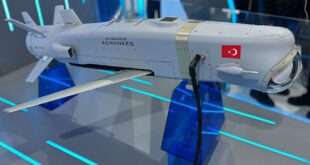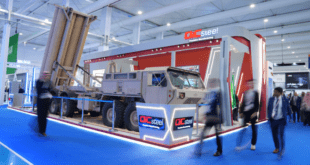On 16 March 2016, DCNS delivered the FREMM frigate Languedoc intended for the French Navy, on the occasion of the acceptance ceremony by OCCAR (Organisation for Joint Armament Cooperation)on behalf of the French DGA (Direction Générale de l’Armement). This event once again demonstrates the industrial success of the largest European naval defence programme. The FREMM frigates are amongst some of the highest-performance latest-generation combat vessels on the market and have already won over three client Navies.
FREMM Languedocis the fifth unit to be built by DCNS and the third intended for the French Navy. The frigate was officially accepted by OCCAR (Organisation for Joint Armament Cooperation), an international organisation for the through-life management of cooperative defence equipment programmes, which has the role of contracting authority for FREMMsintended for France and Italy. The ceremony was presided over by the Director of OCCAR, Timothy Rowntree, and the Armaments Engineer-General, Laurent Sellier, Director of the DGA’s “Armaments Naval Operations” management unit, and in the presence of Pierre Legros, Director of Programmes at DCNS.
The official acceptance of the FREMM Languedocis a demonstration of the satisfaction of the operational personnel that had the opportunity to test its exceptional military qualities in multiple operations theatres. At the start of the year, the Aquitaine and Provence FREMMs participated in the Task Force 50 actions in the Persian-Arabian Gulf, at the sides of the Charles de Gaulle aircraft carrier, designed, built and maintained by DCNS.
These front-line frigates also won over the Royal Moroccan Navy in 2014 and the Egyptian Navy in 2015.
The operational deployments and international successes of this latest-generation frigate demonstrate the capacity of DCNS to design, build and maintain competitive, high-tech vessels, which are perfectly suited to the needs of its clients.
The FREMMs are the first vessels in Europe to deploy the naval cruise missile (MdCN) for which the first firing took place on 19 May 2015 from the FREMM Aquitaine.
“The delivery of the FREMM Languedocre presents an opportunity to highlight the serial effects of a programme that DCNS clients can take advantage of”, notes Anne Bianchi, Director of the FREMM programme at DCNS. “With this fifth unit, DCNS has again improved its industrial and economic performance. It was possible to reduce the duration of the sea acceptance trials for the Languedoc frigateto five weeks, thanks to the experience acquired for the FREMMs already delivered. The DCNS teams and our partners have, in effect, attained an unprecedented level of vessel completion even before its first sea outing”, she underlines.
The FREMM programme represents today the construction of ten vessels, of which eight for the French Navy. Six FREMMs will have been delivered to the French Navy before mid-2019, in accordance with the 2015-2019 military programming law. DCNS is currently completing the FREMM Auvergne, which was floated on 2 September 2015,and is pursuing the assembly of the FREMM Bretagne. Work has started on the eighth FREMM in the series, the Normandie. Last but not least, DCNS is finalising the design of two FREMM swith strengthened anti-aircraft capacities, the delivery of which is slated for 2022.
Overview of the FREMM series
Aquitaine, first in the series, delivered in 2012
Mohammed VI, delivered to the Royal Moroccan Navy in 2014
Provence delivered in June 2015
Tahya Misr, delivered to the Egyptian Navy in June 2015
Languedoc delivered on 16 March 2016
Auvergne, Bretagne and Normandie to be delivered in 2017, 2018 and 2019
Two FREMMs with strengthened anti-aircraft capacities to be delivered in 2021 and2022
FREMM technical characteristics
Heavily armed, the FREMMs deploy the most effective weapon systems and equipment, such as the Herakles multifunction radar, the naval cruise missile (MdCN), the Aster and Exocet MM 40 missiles or the MU 90 torpedoes.
Total length: 142 metres
Width: 20 metres
Displacement: 6,000 tonnes
Maximum speed: 27 knots
Operation: 108 persons (helicopter detachment included)
Accommodation capacity: 145 persons
Range: 6,000 nautical miles at 15 knots
 Defense Arabia Defense Arabia is your source for the latest news on defense, national security and analysis in the Middle East.
Defense Arabia Defense Arabia is your source for the latest news on defense, national security and analysis in the Middle East.



